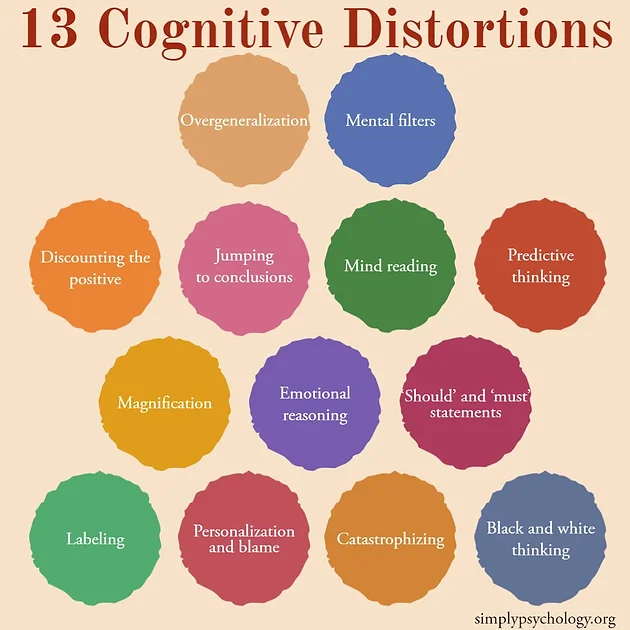Cognitive distortions are just a fancy way of saying faulty or warped or problematic thinking habits. Cognitive distortions are irrational thoughts that affect or even mold our perspectives, our emotions, and our behavior. If we just had these irrational thoughts every now and then, it wouldn’t be a big deal. But it becomes problematic when we think them constantly.
Cognitive distortions go hand in hand with those Stuck Points we talked about. We tend to think in patterns, in automatic, habitual thoughts that cause us to be stuck in self-defeating behaviors, self-fulfilling prophecies, and/or low self-esteem. It’s time for us to take back control over our thoughts!
The first thing we need to do is to be able to identify what thoughts are cognitive distortions. Here are some examples:
- All-or-Nothing Thinking: when we think in extremes and use words like “never,” “always,” “every,” and “all.” For example: I always fail at math tests. This is also considered polarized thinking and over simplifying matters such as when we see things in black or white or good and bad without recognizing the gray areas of a situation.
- Catastrophizing or Exaggerating/Minimizing: this is when we assume the worst possible outcome of a situation. This goes along with exaggerating or minimizing situations where you blow things out of proportion or shrink their importance. For example: It is raining a lot. What if there is a flood?
- Control Fallacies or Blaming: This happens when we think everyone else is to blame for a situation or we believe that it’s only ourselves at fault. For example: “It’s all my fault!” when rarely if ever is it all your fault something happens. There are too many variables for this to be accurate. This can also be when we blame ourselves for things that were not our fault or out of our control.
- Disqualifying the Positive or Filtering: when we choose to only see the negative parts of a situation while ignoring the positive aspects. For example: you have your yearly review at your workplace and you focus on the one negative thing your boss says rather than all the positive things he/she points out.
- Emotional Reasoning: when we assume that the way we feel reflects the reality of a situation. For example: “I feel like a bad person; therefore, I am a bad person.” Or “I feel fear, so I must be in danger.”
- Fallacy of Fairness (also called Heaven’s Reward Fallacy): when we assume life should be fair or when we think we will be rewarded because of our self-sacrifice or devotion. For example: “It’s not fair!” (when this is an unrealistic expectation) or “God will reward me because I’ve given money to charity.”
- Jumping to Conclusions or Predicting the Future: For example: “I was abused by a man, therefore all men are dangerous and not to be trusted.” This can also be over-generalizing when one negative event is perceived to be a never-ending pattern.
- Magical Thinking: When we put too much importance on our thoughts, feelings, or actions on unrelated situations. “I hoped my attacker would die, and now I am at fault for why he died of a heart attack.”
- Mind Reading: An example would be “She looked at me weird. She is probably thinking I am ugly.” These tend to be based on little evidence and are mere assumptions.
- “Should” Statements: this is the belief that things should be a certain way. Example: “I shouldn’t think that,” “I should always be perfect,” and “They should never disappoint me.” This thinking is too rigid to be reasonable and only leads to frustration.
You’re probably like, “OMG, this is way too much information.” And I agree. That’s why I’ve made this post into two parts. Today is recognizing what cognitive distortions are and identifying which category our thoughts fall into. Tomorrow is focusing on how we can change this thinking.
Need more of an explanation? A really excellent video to watch is Emma’s McAdam’s Cognitive Distortions video, which is part of her Therapy in a Nutshell program

